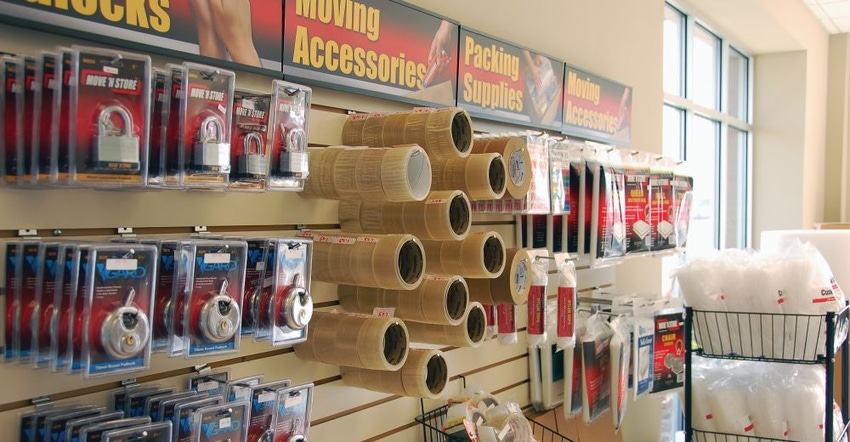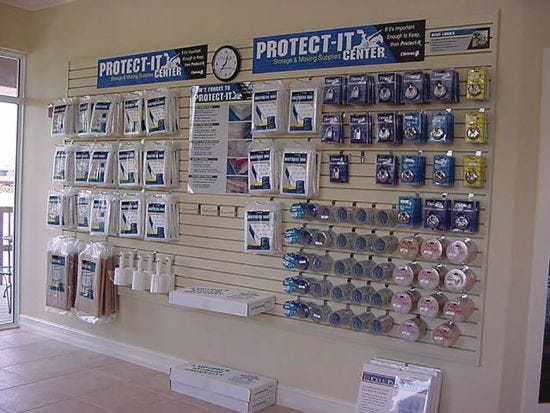Not only do retail merchandise sales add revenue to your self-storage operation, they can ultimately lead to more unit rentals. Learn how to set up a store display and overall program for your moving and packing supplies that’s attractive and effective.
May 22, 2020

At my self-storage company, we track box sales per lease as a measure of our ability to sell retail merchandise. Within our network, stores range from an average of $10 on the low end to $350 at our large U-Haul dealerships, where we sell more boxes to non-storage customers. Whatever that number is, there’s strong consumer demand. In any market, there’s an audience with an appetite for moving and packing supplies, which you can leverage as a profit center for your operation.
Be a Retailer
Not only do retail sales add to your facility revenue, they can help you increase unit rentals. But to succeed, you have to look, behave and think like a retailer. This means you need a laser focus on your showroom setup. Ask all customers if they need boxes and packing supplies, and take them shopping when they indicate they need to buy some items.
To maximize merchandise sales, operators need a desire for profit and should approach the effort seriously, with a motivation to sell and serve customers and neighbors, according to Tony Borysenko, vice president of operations at Chateau Products Inc., which provides wholesale retail product to self-storage operators. Inventory should be plentiful and on full display because you “can’t sell from an empty wagon,” he says.
For older facilities that may not have room in the management office to set up a retail center, consider converting a nearby unit into a showroom. It’s possible to generate more income from that space selling merchandise than collecting monthly rent. In fact, some of us are generating $1.05 per net rentable square foot—applied to the total size of the facility—through non-rental income, which includes box and merchandise sales.
Once you’ve made up your mind to be a retailer, there are many ways to set up and execute a successful retail center and program. Following are some reliable strategies to help you put your best foot forward.
Choosing and Pricing Products
In creating your retail showroom, you’ll need to determine which products are likely to sell best. Here are 10 top-selling items to strongly consider:
Locks (all types, though disc locks are No. 1)
Boxes (all sizes)
Tape (singles and packs with dispensers)
Plastic mattress covers
Plastic furniture covers
Bubble wrap
Foam peanuts
Foam wrap
Box accessories
Tie-down materials
To determine your pricing, take the wholesale cost of your goods and mark them up 2.125 times, so each sale results in 55 percent profit. You want to at least double what you spent, though some popular items, such as moving blankets, may take a markup of as high as a 400 percent.
Enter the initial cost and final price of each item into your management software, then compare total costs vs. sales. Double-check the profit. Inventory can typically be marked within your software reports to distinguish between display items, returns, damaged products, etc., which helps balance each line item.
Finally, consider using bundles. Create combinations of boxes and other products at a discounted package price, creating one-bedroom kits, kitchen kits, etc. These make it easy to sell in quantity. Display your bundles with a note about what’s in each kit, along with the discount that’s applied when purchased.
Designing Your Space
First impressions count. Keep your showroom well-stocked, with prices clearly marked on all items. Everything should be clean and ready to sell.
We like to stack boxes about 4 feet high and use furniture movers as floaters for the box stacks. This allows you to move the display around easily and keep the floor tidy and clean. On top of the stack, indicate the price for each box size and any bundle price. You might also list the most common uses for each box size.
As with any product or service, signage informs customers, but don’t use paper. Signs can easily be produced online or at a local shop with vinyl lettering on any number of inexpensive materials, such as brushed-aluminum laminate or polystyrene. Hang signs over merchandise to make messages clear and easy to understand. Put “Boxes & Supplies” in bold lettering over your slat wall, so when you photograph the area to include in marketing materials or display on your website, it’s labeled and does the selling for you. Whatever signage you produce, include your company logo.

The retail center at Avondale Self Storage in Avondale, La.
Training Staff to Sell and Serve
Managers need to be trained to sell your retail product. For example, they should ask new customers not to pack their items for storage until they’ve had a chance to visit your showroom, as it’s the best in town. They should make it clear that they can teach the customer valuable ways to simplify the move-in process and get the most out of their storage space and experience.
Once a customer walks into your showroom, simply asking “What will you be packing today?” is all it takes to get him talking about his needs. Take him shopping. Remind him of any box-bundle pricing on 10 or more of the same size. Give him a 10 percent discount, and then mention you have a box buyback program for any unused, clean items that can be put back into inventory. These types of programs give consumers peace of mind when purchasing.
Everyone wants to experience great customer service, and many are willing to pay extra for it. Do you stand to greet and assist customers in the showroom, or do you just point toward the merchandise? Do you help load purchases into customer vehicles or allow them to struggle getting out the door? Helping customers and taking extra steps to provide superior service should be the standard. Here are a couple other unique strategies to try:
Consider a billing option for unit renters who buy retail product. Offer to add their purchase to their next monthly invoice rather than make them pay on the spot. This is a great way to build loyalty and provide a convenience they’re not likely to get elsewhere. This is really easy to set up if the customer is paying rent with a credit card.
If you have a rental truck, consider offering free delivery of retail product on orders $199 and more within 10 miles. This is another customer convenience that also gets your truck visible in surrounding neighborhoods.
Promoting Your Product
The talking points you use to upsell retail merchandise comprise the messaging you’ll want to use as part of your marketing strategy. Mention what distinguishes your retail program in social media campaigns and e-mail blasts. When customers walk through the door or call the property, reinforce that messaging.
Use some form of creative outdoor signage to let passersby know you’re in the retail business and carry all the items people need for packing and moving. This can be done by creating a “snowman” out of boxes. Most of us who do this put the display out each morning and bring in at night.
Consider running special programs. For example, in January, run a “get organized” sale by putting older merchandise in a 50-percent-off bin by the checkout counter. Trust me, it’ll move quickly.

A nicely organized retail wall
Tracking Sales and Inventory
If you tell an employee you want him to sell $5,000 worth of merchandise each month, he may be overwhelmed. However, if you tell him the goal is to sell $25 or $40 of merchandise per move-in, this is more easy to comprehend and less intimidating. We track this number daily. It’s easy to calculate: Just divide all merchandise sales by all leases for the same period, monthly and annually. The information is typically found in the management summary of most software packages.
Managing inventory and creating a reorder cycle is an important part of your retail program. Balance inventory on a monthly basis using your management software. This will help you keep losses to a minimum and identify if there’s a problem with theft. The only way to ensure you’re making the profit you intend is by balancing the inventory and checking that all new shipments received are correct and placed in the system. This will also help you identify when it’s time to reorder as well as which items are your best sellers.
If you decide to add or revamp a retail program at your self-storage facility, you don’t have to go it alone. Most merchandise vendors are willing to help you set up a professional display and choose products and will recommend appropriate markups. Once your showroom is set up, market it to your entire database. You should quickly begin to see improved income as well as enjoy the satisfaction in helping your customers save time and energy by shopping with you.
M. Anne Ballard is president of training, marketing and developmental services for Universal Storage Group and the founder of Universal Management Co. She’s past president of the Georgia Self Storage Association and has served on the national Self Storage Association’s board of directors. She’s also participated in the planning, design and operation of numerous storage facilities. For more information, call 770.801.1888; visit www.universalstoragegroup.com.
About the Author(s)
You May Also Like





